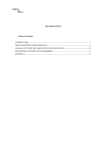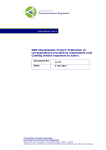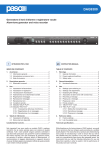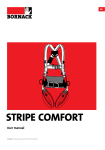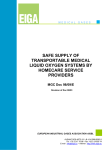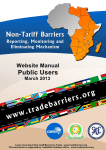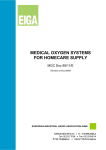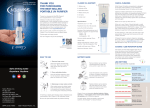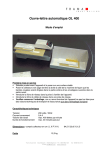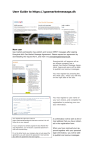Download here - Elecpor
Transcript
ACER’s Public Consultation on REMIT’s Trade Reporting Manual A EURELECTRIC response paper May 2014 EURELECTRIC is the voice of the electricity industry in Europe. We speak for more than 3,500 companies in power generation, distribution, and supply. We Stand For: Carbon-neutral electricity by 2050 We have committed to making Europe’s electricity cleaner. To deliver, we need to make use of all low-carbon technologies: more renewables, but also clean coal and gas, and nuclear. Efficient electric technologies in transport and buildings, combined with the development of smart grids and a major push in energy efficiency play a key role in reducing fossil fuel consumption and making our electricity more sustainable. Competitive electricity for our customers We support well-functioning, distortion-free energy and carbon markets as the best way to produce electricity and reduce emissions cost-efficiently. Integrated EU-wide electricity and gas markets are also crucial to offer our customers the full benefits of liberalisation: they ensure the best use of generation resources, improve security of supply, allow full EU-wide competition, and increase customer choice. Continent-wide electricity through a coherent European approach Europe’s energy and climate challenges can only be solved by European – or even global – policies, not incoherent national measures. Such policies should complement, not contradict each other: coherent and integrated approaches reduce costs. This will encourage effective investment to ensure a sustainable and reliable electricity supply for Europe’s businesses and consumers. EURELECTRIC. Electricity for Europe. Dépôt légal: D/2014/12.105/15 ACER’s Public Consultation on REMIT’s Trade Reporting User Manual A EURELECTRIC response paper May 2014 KEY MESSAGES We welcome the effort made by ACER to produce the Transaction Reporting User Manual and also to aim at publishing it together with the Implementing Acts. For market participants it is important that valuable guidance on the reporting process is provided. At the same time, we would like to emphasize that it would be very beneficial to also include examples and provide more specific guidance on how to populate the relevant data fields for a report on individual standard transactions (including orders) and non-standard transactions. EURELECTRIC believes that any future additional parts should be consulted with market participants before being officially issued as part of the TRUM. In particular - although reporting obligations for non-standardised contracts will enter into force later - EURELECTRIC believes that the section 6.2 related to those contracts needs to be drafted as soon as possible to help market participants to anticipate and trigger all necessary organisational measures and IT investments. EURELECTRIC believes that the TRUM proposals on data integrity may be in contrast with the wellknown REMIT requirement of not creating unnecessary costs or administrative burdens for market participants reporting transactions and fundamental data. The responsibility of market participants must be strictly related to the reliability of reported data. No larger responsibility should be attributed to them in terms of checking the services provided by RRMs, especially if not previously envisaged by primary legislation. As already mentioned on several occasions, as far as transaction reporting under REMIT is concerned, EURELECTRIC generally considers that the organized market places are the best placed to do the reporting and should thus have a clear primary obligation to report all trades executed over their platforms (including orders to trade), whilst leaving the choice to the market participant to still report these deals directly to an authorized RRM or directly to ACER as RRM. Once the market participant has provided timely all necessary data to the RRM or the RIS reporting on its behalf, it should be explicitly released from any liability with respect to its reporting or publication obligations under REMIT. This is not sufficiently reflected in the draft TRUM. For market participants opting for direct reporting - EURELECTRIC believes that self-reporting entities need to have lighter requirements than RRM reporting on for third parties in order to avoid unnecessary burden and IT development costs. TF Financial Regulation & Market Integrity Chair: Bernhard WALTER Contact: Charlotte Renaud – Advisor Market Unit [email protected] Anne-Malorie Géron – Head of Unit Market – [email protected] Consultation questions 1. The Agency currently understands that the attached data fields (see Annex I of the draft TRUM) for the reporting of transactions in standardised and non-standardised contracts will be included in the Commission’s implementing acts. Please provide us with your views on the attached data fields. One specific comment on the "standardised contracts": many fields for standard contracts are redundant if implementing a field containing Unique Product Identifiers (UPI) (which also be defined for energy products) and Unique Transactions ID (UTI). Given the diversity and the complexity of such non-standardised contracts, we would like ACER to specify which fields are required on a compulsory basis and which are not. Indeed, a “one-size-fitsall” table is not realistic for the non-standardised world. Therefore, a workable and pragmatic solution is needed. Further, EURELECTRIC is still confused about the lack of clarity as regards the notions of “transactions” and “contracts” which seem to be used at random. While the table systematically refers to “details of contracts”, we believe that this wording should be consistently used over the whole document. Please find our detailed comments on the attached data fields in the annexes for both standardised and non-standardised contracts. 2. Please provide us with your general comments on the purpose and structure of the draft TRUM, annexed to the consultation paper. We welcome the effort made by ACER to produce the Transaction Reporting User Manual and also to aim at publishing it together with the Implementing Acts. For market participants it is important that valuable guidance on the reporting process is provided. At the same time, we would like to emphasize that it would be very beneficial to also include examples and provide more specific guidance on how to populate all data fields for a report on individual standard transactions (including orders) and non-standard transactions. Although reporting obligations for non-standardised contracts will enter into force later, EURELECTRIC believes that the section 6.2 related to “reporting details of non-standardised contracts” needs to be drafted as soon as possible to help market participants to anticipate and trigger all necessary organisational measures and IT investments. Given the variety and complexity of reportable non-standardised contracts, we believe that leaving enough time is key to ensure both an efficient and reliable reporting. Some additional general comments about the draft TRUM: The draft TRUM should specify for each data field: o If it is a mandatory field or not; o If it’s mandatory and not applicable, can it be left blank or which default value be used such as “N/A”; o If and how (-> tolerances) the fields will be checked by verifications / reconciliations with the counterparty data; the lower the number of fields to be matched, the easier the matching and need for updating/ correcting (and cost of such) will be; unlike EMIR, the draft TRUM does not seem to make a distinction between counterparty data and common data: not all fields can match if both sides of the trade report are separately: e.g. as Buy/Sell indicator (field 11), 4 Initiator/Aggressor (field 12), Beneficiary ID (field 8), etc. will be different for each counterparty. o The precision required for the field (decimal places for floating values, if hours/minutes/seconds are relevant for date data fields, etc.). With regard to 3.2 of the TRUM, we understand that there will be a public list of standardized contracts. We would appreciate this list to be exhaustive. Market participants should be able to conclusively rely on this list in order to determine what is reportable for compliance purposes. It is important that market participants can map the listed standard contracts to the transactions in their trading systems. It also needs to be taken into account that market participants need sufficient time to adjust their systems. Hence a “phase-in” period should be granted if a new product is added to this list. We would thus need further explanation about how the standard contracts will be described. It would be helpful if some examples would be provided, maybe add example of format into one field list. Also add what fields are mandatory (depending on traded on organised marketplace etc.). The first reporting date shall apply six months after the adoption of the Implementing Acts. The expected timeline for the adoption is so far approx. 1 July 2014. As a consequence the first reporting date would be around the dates of Christmas and New Year 2014/15. EMIR transaction reporting started on 12 February 2014 and proved to create a heavy workload before and after the launch. Thus we strongly recommend a first reporting date that does not start earlier than 20 January 2015. Unlike EMIR, the draft TRUM does not seem to make a distinction between counterparty data and common data. o We anticipate that not every field is expected to match when both sides of the trade report separately. o Obviously fields such as Buy/Sell indicator (11), Initiator/Aggressor (12), Beneficiary ID (8), etc. will be different for each counterparty; It would be helpful to know what fields must match to minimise the need for minor inaccuracies to have to be constantly amended if it does not affect the matching and understanding of the details and effect of a contract. We would welcome clarification on the points below: o Does REMIT differentiate between standard contract and standard product (standard product is certain load profile at certain market)? o Are bilateral contracts with standard product (same load profile as it is traded on organized market places, recognized as standard contract by ACER) recognized as non-standard contract, since those bilateral contract usually have different payment obligations, different risk parameters and therefore can have prices, which differ from same standard contract for same standard product on organized market places? o It should be made clear that intragroup transactions should not be required to be reported o There should be clear guidance on how to deal with voice-brokered orders. Additionally, we would like to recall here some key EURELECTRIC’s positions previously mentioned and relevant in the context of this consultation. 5 REPORTING OBLIGATION FOR EXCHANGES AND TSOs & UPCOMING REQUIREMENTS FOR RRMs As already mentioned on several occasions, as far as transaction reporting under REMIT is concerned, EURELECTRIC generally considers that the organized market places should have a clear primary obligation to report all trades executed over their platforms (including orders to trade), whilst leaving the choice to the market participant to still report these deals directly to an authorized RRM or directly to ACER as RRM. Only market participants should have the right to opt-out as market places are generally (unless in case of smaller broker platforms) the best placed to do the reporting; and direct reporting or reporting via third parties like matching platforms could be tough and extremely expensive for some market participants. This should be recognised in Art. 5(6) of the draft REMIT Implementing Acts and reconfirmed in the TRUM. However as mentioned above, market participants should always have the option to report certain contracts directly to ACER as RRM which might be a more economical solution for some market participants. Hence the requirements for market participants who only report their proper trades and/or trades of their group members should be lower than for third parties whose business model is to provide reporting service. Furthermore, we believe that there should also be controls and recommendations regarding the potential fees that may be charged by organised market places RRMs reporting on behalf of market participants (also to ensure consistency across Europe) including public consultations. Concerning reporting on balancing services, as TSOs are central counterparties for them, they should have the same obligation as organized market places to report. Last but not least, we noticed that no guidelines have been provided so far on order reporting. EURELECTRIC would request ACER to address this in future TRUM document releases. STRICT ALIGNMENT OF THE REMIT REPORTING WITH THE EMIR REPORTING IN ORDER TO AVOID DOUBLE REPORTING Broadly speaking, we welcome the efforts made by ACER and DG ENER to align data reporting under REMIT and EMIR for standard transactions in the last version of the REMIT draft implementing acts. We are in particular supportive of the provisions of articles 5(4) and 5(5), the latter explicitly confirming that once trades have been reported under EMIR to a trade repository then these are no longer necessary to be reported under REMIT by the market participants. We would appreciate this clear information – being that the reporting obligation under REMIT is fulfilled when reported under EMIR- to be also clearly mentioned in the draft TRUM. We notice that some additional alignment could be done between EMIR and REMIT regarding some of the values to be populated in particular data fields (e.g. data field 2, 8, 25, 26, etc.), as further detailed in this document. 6 3. The Agency has currently identified a set of standard formats to be used in the reporting framework (see Chapter 5 of the draft TRUM). Do you consider these standard formats relevant? Are there any other standards that the Agency should consider? We consider the set of standard formats identified by ACER and to be used in the reporting framework as relevant and sufficient. We propose to adhere to the same standards as currently used for other regulatory reporting such as EMIR (see also below). It is not necessary to consider any other standards. 4. Please provide us with your views on the field guidelines for the reporting of transactions in standardised supply contracts (see Chapter 6 of the draft TRUM). Please find detailed comments on the field guidelines in the annex 1. 5. Do you agree that for the reporting of energy derivatives, the same standards that apply under EMIR and MiFID should apply under REMIT (see Chapter 7 of the draft TRUM)? For energy derivatives that are reported under EMIR, and that market participants do not have to report once again under REMIT, ACER should obtain those contract details for REMIT purposes directly from ESMA/TRs if needed. We would welcome clarity as to which Annex/ data fields are reportable for derivatives under REMIT. We, however, do agree that the format in which information is accepted by ACER must be aligned to the format the information is accepted by trade repositories under EMIR to minimise IT expense for market participants. 6. The Agency intends to include in the TRUM guidance on how trade reports shall be reported for different trading scenarios (see Chapter 8 of the draft TRUM). Please provide us with your views on which trading scenarios you would consider useful to cover in the TRUM. We understand that ACER means by “trading scenario”, a chain of (reportable) wholesale energy transactions. In this respect, trading scenarios for section 8 of the draft TRUM should look to cover the agency trading structure employed by many energy companies – therefore clarifying if there is any obligation to report for the agent. Some examples of useful trading scenario's to consider would be: Novation, termination ; Trades as a result of portfolio compression (also important in light of the backloading obligation, all original deals may no longer be available in the system since compression & novation); Trading scenario: 7 Additionally, it would be helpful if the draft TRUM included some example trades as an appendix with each field populated for them (e.g. German power peak trade for summer 15 @ 10MW / hour, UK gas NBP trade for winter 16 @ 25,000 therms/day, swing deals,…). Therefore clarifying the relationship between numerous date and quantity/capacity fields. 7. Please provide us with your views on the section in the draft TRUM related to data integrity (see Chapter 9 of the draft TRUM). For submitting relevant comments we miss the documents quoted in Article 4.2, i.e. the ACER Requirements for Registered Reporting Mechanism & Technical Specifications for Registered Reporting Mechanisms. It is thus difficult to provide any qualified comments without these documents. Firstly, EURELECTRIC believes that the TRUM proposals on data integrity may be in contrast with the well-known REMIT requirement of not creating unnecessary costs or administrative burdens for market participants reporting transactions and fundamental data. In order to minimize costs for market participants, they should not be required but to verify that third party RRMs are fulfilling the requirements by the Agency (including that the RRM has robust governance and control process and mechanisms in place to ensure the accuracy and completeness of the reporting (§9.3), nor should they perform regular checks with the RRM. The only obligation resting on the market participant should be to verify that the RRM has a valid ACER registration, meaning that ACER considered appropriate the business model of the RRM and ascertained its compliance with the requirements and the technical specifications for reporting entities. Additional obligations on the RRM could be considered by the Agency in line with requirements resting on TRs under EMIR and ESMA’s surveillance, investigatory and penalising powers. The responsibility of market participants must be strictly limited and related to the reliability of reported data. No larger responsibility should be attributed to them in terms of checking the services provided by RRMs, especially if not previously envisaged by primary legislation. Secondly, we regret that data protection and confidentiality issues are not addressed in the consultation. Given the level and the granularity of the information to be transferred to ACER, and to be exchanged between ACER and the NRAs, we are very concerned about the lack of provisions in the REMIT Implementing Acts in order to ensure data security and data-record keeping framework. Indeed the data to be reported to ACER and exchanged between NRAs and ACER are of highly sensitive nature. If these data were to be hacked this would entail very serious consequences for the European energy market and for market participants. It is therefore essential that ACER and the NRAs ensure very high standards of data security and are requested to provide assurances on this point to market participants (e.g. by providing the relevant ISO certifications on data security). This should be an issue addressed both in the REMIT Implementing Acts and in the chapter 9 of the TRUM on data integrity. Last but not least, we remark that some parts of the TRUM are not being consulted in this phase. EURELECTRIC believes that any additional parts should be consulted with market participants before being officially issued as part of the TRUM. 8 Additionally, we would welcome further clarification on the following points: - - - - Let’s take the example of a market participant (MP) trading over 10 organised market places (i.e. RRMs). Such MP will have to comply with 10 different governance and control process of 10 different RRMs. We see high potential risk of excessive administrative burdens and costs imposed on the MPs Also, we would like ACER to specify the verification process which the Agency would be recommending to MP to introduce as “robust governance and control process and mechanisms” for outsourcing of RRM. Section 9.2: “the Agency expects the MPs compliance to include, a.o., that testing is comprehensive (…), meaning that testing should include making sure that the reports are properly submitted to the Agency.” Market participants cannot test the link between authorised RRMs and the ACER and can only rely on the clarifications provided by the RRM on the proper functioning of the link between the RRM and the Agency. Overall, the compliance framework expected by the Agency will imply significant costs. As organised market places will have a primary obligation to report orders to trade and transactions executed on their platform, please explicitly confirm in the TRUM that they will have to register as a RRM. Does the Agency recommend some minimum standards of SLA/agreements/contracts between 3rd party RRM and MP? It would be helpful if ACER could specify level of errors/fails beyond which the MP is obliged to notify the Agency. Please explicitly state in the TRUM, as mentioned during the ACER public workshop on April 3rd, that when a group (e.g. holding) reports on behalf of its group companies, all REMIT reportable trades to a third party service provider, that only that third service provider should register as a RRM, being the one having the final connection with the ACER and not the holding company. We would also like to recall here some key EURELECTRIC’s positions previously mentioned and relevant in the context of this consultation. - We understand from REMIT that, while the overall responsibility of the reporting lies with the market participant, the reporting obligation shall be considered to be fulfilled if the information is received by a third party acting on behalf of the market participant, an organized market place, a trade repository, a trade reporting system, or a competent authority/ESM. Once the market participant has provided timely all necessary data to the RRM or the RIS reporting on its behalf, it should be explicitly released from any liability with respect to its reporting or publication obligations under REMIT. This is not sufficiently reflected in the draft TRUM. It should be for example expressly provided for that the compliance of a market participant with reporting obligations is considered fulfilled when a contract exists between the market participant and the third party stating that the third party is in charge of reporting on behalf of the market participant. It should also be made clear that market participants on whose behalf data is reported remain owners of the data and must have access to the data (and not only to samples from the website), in order to be in a position to answer adequately any potential upcoming questions. - Also the requirements (i) that for all transactions market participants check « the accuracy of the individual data fields and their compliance with [ACER] guidance» and (ii) that they provide ACER with an extremely detailed report of errors and failures seem to imply a disproportionate cost for market participants. 9 - Furthermore - for market participants opting for direct reporting - EURELECTRIC believes that self-reporting entities need to have lighter requirements than other RRM in order to avoid unnecessary burden and IT development costs and in order to make effectively available the option for market participants to report themselves or for transactions with group members as counterparties. Such requirements should be subject to consultation as soon as possible, in order to allow market participants to evaluate carefully all the options available to comply with their respective reporting obligation. - The status of third party entities reporting on behalf of market participants (service providers, trade repositories...) should be clarified. As mentioned above, it should be explicitly mentioned in a document that once the market participant has provided timely all necessary data to the third party RRM, it will be discharged from any liability related to its reporting obligation under REMIT. We would also expect such a rule to be applied to platforms that will report “fundamental data”. In this context, it could be envisaged that ACER determine eligible “third party RRMs” with proper investigation processes and checks the accuracy and the completeness of the data received through random checks or audits. - Finally, ACER should quickly specify what it expects regarding RRMs’ fall-back solution and what would be the role of each type of RRMs. Market participants also need to know what would be the fall-back solution of a reporting in the ARIS system should it failed. 8. Additional comments to the TRUM Under §10 (FAQ), Q4, the Agency stipulates that “the market participant should ensure that the report is submitted only once to the Agency”. It would be helpful if ACER could clarify this taking into account that for each trade, there are two counterparties having in fact the reporting obligation. 10 Annex 1 - Comments on specific data fields for the reporting of standardised transactions Field 2: Type of code used in field 1 (comment also applies to field 6 and field 9) Although not strictly EMIR fields, these fields are already used by some of the EMIR trade repositories. However they use the convention “LEI” instead of “L”. It would be helpful if these fields were aligned with the EMIR trade repositories in order to minimise the number of extra reporting fields under REMIT. Market participants should be able to identify the counterparty to a trade by any of the ID codes foreseen in the TRUM, without the prerequisite that this code was also communicated by the market participant at the registration phase with the NRA. See also comment under field 5 Field 3: Trader ID as identified by the organised market place Please note that for some marketplaces, one account may be shared by multiple individuals. Field 4: Trader ID for the market participant or counterparty The trader ID should be the user name as stored in the internal trade capture system/as used at the regulated market. Those user names might differ but that should be permitted to use different Trader ID. Is this field in accordance with protection of personal data? Field 5: ID of the other market participant or counterparty a) The draft TRUM outlines that the code to be used should be the same as the code that has been registered with ACER during the participant registration process. What will happen, if some market participant, who trade derivatives and report them with LEI under EMIR, will not register this LEI with ACER during the market participant registration process, but with some other code type, e.g. EIC? It should thus be sufficient to use an LEI in all cases (if available, as counterparties will be using these codes under EMIR and there is a 1:1 mapping to the ACER code (information is publicly available) even if a counterparty used another code during the participant registration process. If not, companies will be required to maintain multiple sets of identifies for their counterparties – a LEI for EMIR reporting, and potentially a separate ACER registration code for REMIT reporting. This would lead to high costs for setting up and maintaining the data and also might lead to inconsistencies. b) It is not clear what a market participant should do if the other counterparty has not registered and a proper reporting cannot take place (we will not be able to assign the correct ID). 11 Field 7: Reporting entity ID Does this field refer to the identification of a party performing delegated reporting as RRM? In case of delegation to a RRM, if the RRM has a LEI this identification code should be used as identifier. Field 8: Beneficiary Identification of the market participant or counterparty referenced in field 1 The notes to field 10 (trading capacity) state that if principal (“P”) then the value for Beneficiary is not applicable. This is not consistent with EMIR reporting, as the ESMA Q&As (TR Question 9) state that if counterparty is itself the beneficiary to a trade; it should be reported in both the counterparty and beneficiary fields. Given that these fields are also used in EMIR reporting, the logic for populating them should be aligned to ensure that existing internal reporting systems can also be used for REMIT reporting. Further clarification would be thus welcome about the beneficiary definition. Field 11: Buy-Sell indicators In some situations, some contracts can be for both buying and selling of different commodities or same commodity on different delivery point. This situation could be solved if in the next row (contract type) the physical swap contract can be chosen. Field 12: Initiator/Aggressor If reporting obligation for these contracts is not on brokers this information is not possible to be reported as market participants usually do not collected this information( for possible back loading, this is impossible). Setting up this information in the front office / deal capturing systems would be very costly for market participants hence we support that this information has to be provided by the organised marketplace. Field 17-22: The request of reporting orders characteristics which reveal commercial strategies should not be collected according to recital (12) of REMIT. Field 23: Contract ID a) Is this field expected to be populated for OTC transactions? Does the responsibility lie with the brokers to provide? b) If a transaction is executed bilaterally with no broker, EURELECTRIC recommends ACER to provide a list or a set of criteria of applicable unique identifiers. c) What do the terms "contract" and "transaction" mean? And in which case is it an UTI? Having said this, what is required then in field 28? Or does "contract' mean "product"? d) How is this field interacting with fields 28, 29 and 31? 12 Field 24: Contract type Having regard to the focus of the draft TRUM on the reporting of the standard contracts, we would appreciate the exact definitions/ other characteristics of each Contract type (to avoid the excessive use of OT= other types). We would welcome examples of contract types ACER anticipates should be differentiated. The contract type “SW” is not relevant as derivative contracts are already to be reported under EMIR and thus are not reportable under REMIT. At the same time, the required information is partially redundant. Some of the types can be derived from start/end date/time of that transaction. E.g. whether a contract is IND, DAY or FW or whether a contract is SPI or FWI. We thus suggest merging the contract types mentioned above. Field 25: Energy Commodity To minimise the number of additional fields under REMIT against EMIR, this field could be aligned with EMIR common data field 46 Commodity Details – with electricity as “EL”, and natural gas as “NG”, instead of respectively “E” and “G”. Field 26: Transaction timestamp a) Alignment with EMIR reporting is necessary: i.e. data field “Reporting Timestamp” and “Execution Timestamp”. The draft TRUM this field is to represent the date and time of the event, referred to in field Action Type. It should be clarified how the exact process should be in case of modifications to a trade. b) The draft TRUM states that this field has to be reported in milliseconds. This is not only unrealistic but also inconsistent with the trade reporting under EMIR which is to seconds only. Keeping as seconds would also align the format with that of REMIT fields 51, 52 and 60. For bilateral trades even minutes can’t be matched to the information submitted by the counterparty (although deals are captured ad hoc in the systems this manual activity requires time) c) For non-platform transactions we see major difficulties to provide this information (especially identical execution timestamp for both counterparties seems not possible) Field 27: Contract name We assume this can be left blank in case the trade is not executed on an organised market place, please confirm. It is not clear what this field adds that is not provided in field 23. Contract ID. Redundant data fields should be avoided. Field 28: Transaction ID For fields 23, 28 and 29, we would appreciate an example illustrating which ID's are used in a chain of transactions. Currently we do not fully understand all of these ID's, which are mandatory and who is the owner of each ID among all involved actors. 13 If counterparties are expected to report a unique transaction ID, then there must exist a framework to generate such IDs so that they are unique between the two counterparties, whilst indicating which party to a transaction should generate and communicate the unique identifier (taking into account different trading scenario’s).. The experience of EMIR reporting showed that the reconciliation of a single transaction ID may not be easy if left to the simple agreement among the parties and that the identification of mandatory rules and criteria may help The draft TRUM should clarify whether this field is to be populated in the same way as the UTI under EMIR reporting. Field 29: Linked transaction ID The draft TRUM should provide some trading examples of when this field would be required to be populated. The obligation to provide a linked transaction ID seems to rest with the organised market places. Thus it would be helpful to know how to proceed if organised market places do not provide at all these information or not within the reporting timeframe (D+1). Field 30: Linked order ID The draft TRUM makes reference to field 19 within the notes to this field; we assume that should be referring to field 13 (Order ID). It is not reasonable to expect counterparties to be able to capture individual order IDs (which are being reported by organised market places) and link applicable order IDs to executed transactions. If required, all this set of information should be then provided by market places. Field 31: Transaction reference number The draft Implementing Act uses the same field explanation as EMIR; however under EMIR this field is now only applicable to exchange traded derivatives. Clarity under which trading scenarios this field would be expected to be populated under REMIT would be appreciated. In this context we would also see a need to clarify the difference between Transaction reference number (Standard contract, Field No. 31) and Contract ID (Standard contract, Field No. 23). Field 32: Organised market place identification/OTC This field has been largely aligned with the EMIR common data field Venue of execution. However the draft TRUM introduces a new code of “OTC” for over-the-counter trades whereas EMIR uses the code “XXXX”. Having different codes for different European reporting regimes (for basically the same field) increases the complexity and cost of internal reporting systems. Alignment would be recommendable Field 33: Voice-brokered Reporting obligation for these contracts should be clearly on brokers. 14 Field 34: Price a) In case of options, it is not clear how to populate this field (premium; total premium amount; a premium rate per commodity unit?). b) The draft TRUM uses the format “53,45” as an example of the price to be reported. We assume that “53.45” is also acceptable. c) For index priced deals it is unclear how to treat this field. Field 35: Fixing Index More clarification on this field is needed (e.g. whether it is a free text field). - If so, it will most likely not match between the two parties on the trade. If not, will there be a list of indexes? Field 36: Index value The draft TRUM should clarify whether populating this field means that field 34 can be reported blank. As the index needs to be reported and the settlement values can be officially accessed (-> e.g. EEX / ICE), there is no reason that reporting participants need to provide this information. Field 38: Notional amount and Field 40: Quantity and Field 41: Total notional contract quantity Generally, the draft TRUM should include some transaction examples to illustrate the difference between all of these fields (particularly fields 40 and 41). Also, we see the need for clarification on Field 38 “notional amount”; especially that this does not require valuation of the contract (MtM) as there is no obligation under REMIT to report this. Field 40: Quantity Not always clear on how to report. For example: If I have 20 contracts of 10 MWh, is "10" the correct number for field 40? Field 41: Total Notional Contract Quantity This field ("Total notional contract quantity") is in our view not required as already field 38 "Notional amount" and field 40 "Quantity" are reported. Not always clear on how to report. For example: If I have 20 contracts of 10 MWh, is then the correct number for field 41: 200? Field 42: Quantity unit As this field is a text format, it would be helpful if the TRUM included a pre-defined list of accepted values in order to avoid some counterparties reporting different values for the same unit (e.g. MW, MWH, MW/H, etc). If this is why the draft TRUM (page 13) mentions the UN/ECE recommendation 20 for measurement units than this should be referenced in the text under this field. Additionally, it would be helpful if the TRUM outlined which quantity units to report for different contracts to avoid one counterparty reporting in, for example, “therms” and the other counterparty reporting “ktherms”. 15 Field 43: Settlement method Considering that products under EMIR are supposed to be excluded from reporting under REMIT, cash settled transactions should not be in the scope of the REMIT transaction reporting. Physically settled contracts, that should be classified as such, will in some instances have an element of cash settlement in the case of bankruptcy of one of the counterparties. It should be clarified that this is still acceptable to classify such contract as "P for physically settled". Field 44: Maturity date Does expiry relate to delivery or settlement? If delivery, is this field expected to be different than field 52 Delivery end date and time (excluding the timestamp)? If settlement, then suggest that this field be re-named as Settlement date to be consistent with EMIR reporting. Field 48: Option exercise date The examples shown in the draft TRUM should be revised as they are in the format dd/mm/yyyy and not UTC date format yyyy-mm-dd. The text only refers to dates where an option is exercised. Should it also include dates where the option could be exercised, in case it is not exercised? Field 49: Option Strike price Reference to field no 25 is probably a mistake. Field 53: Duration This is redundant information and can be derived from start/end date/time. We suggest removing this field. Field 55: Days of the week For this field there must be detailed explanation with relevant examples. For example: Would the code all days “AD” be applicable to a three-day gas trade which delivers over the days Friday, Saturday, and Sunday? Field 56: Load delivery intervals The draft TRUM outlines that this field be reported in ”ISO 8601 date format” - however, the example provided does not reflect this. Also, we propose that the TRUM outlines how the reporting of multiple delivery intervals can be achieved in the same field, e.g. separated by semi-colons. Generally, we assume that this field should apply to non-standard (profiled) contracts. If so, we would expect the intervals to be specified by date and time, instead of just by time. Thus this field should be removed from the standard reporting form. 16 Field 57: Delivery capacity It would be useful if the TRUM outlined how this field is different to fields 40. Quantity and 41. Total notional contract quantity. In our view, this field should be deleted as for standardised contracts, there is no flexibility ranges, options, etc. Field 58: Quantity unit used in field no 57 There seems to be overlap between this field and field no. 42. One solution could be that field no. 58 should only be filled in, if the unit is different from the quantity unit in field no. 42. Field 59: Price/time interval quantity The TRUM should outline whether this field can be reported blank for non-block hour trades. Also, would this field have to be reported if the price is constant for the same block hours for each day of delivery? In our view it would be more logical to provide the price per quantity unit per delivery time interval. Field 60: Confirmation Timestamp We are of the opinion that this filed should be deleted. We do not the obligation of timely confirmation as a relevant provision under REMIT. In fact REMIT does not include any risk mitigation techniques. 17 Annex 2 - Comments on specific data fields for the reporting of non-standardised transactions EURELECTRIC welcomes the decision to favor qualitative over quantitative data. In general, a number of comments made to the standardized reporting format, remain also valid for the reporting format of non-standardised contracts (e.g. fields 2, 4 and 7 = comment re field 1 and 6 of Annex 1; etc.). Below, EURELECTRIC focuses on specific data fields only. In any case, we expect that a new consultation paper will be issued by the Agency before the TRUM is expanded later as to cover the reporting format of non-standardised supply contracts. Field 17: Estimated Notional Amount This value, corresponds to the total or the remaining value of the contract? More clarification is needed. Field 27: Price Formula This should be deleted. Complex formulas cannot be entered here. Additionally this information is too confidential to be in a data base and does not add useful information for monitoring purposes. Of course this could be shown to the regulator under specific request. Field 31 &32: First and Last fixing date What is a fixing date for a physical contract: the days that set the price of the contract? Field 20: Total Notional Contract Quantity As previously mentioned, more clarity is needed. What happens with non-standard contract in which it is very difficult to calculate a figure (for example, when this contracts are linked to optionally)? What happens when two counterparties are reporting different quantities? 18 EURELECTRIC pursues in all its activities the application of the following sustainable development values: Economic Development Growth, added-value, efficiency Environmental Leadership Commitment, innovation, pro-activeness Social Responsibility Transparency, ethics, accountability Union of the Electricity Industry - EURELECTRIC aisbl Boulevard de l’Impératrice, 66 - bte 2 B - 1000 Brussels • Belgium Tel: + 32 2 515 10 00 • Fax: + 32 2 515 10 10 VAT: BE 0462 679 112 • www.eurelectric.org





















